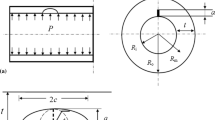Abstract
This study proposes two new methods to estimate the energy release rate of a circumferentially cracked pipe with an internal, constant-depth, finite-length surface flaw subjected to pure bending loads. The methods are based on the deformation theory of plasticity, constitutive law characterized by Ramberg-Osgood model, and an equivalence criterion incorporating reduced thickness analogy for simulating system compliance due to the presence of a crack. Closed-form solutions were developed in terms of elementary functions for an approximate evaluation of J-integral. They are general and can be applied in the complete range between elastic and fully plastic conditions. Several numerical examples are presented to illustrate the proposed methods. The comparisons with the results of elastic-plastic finite element analysis showed satisfactory prediction of J-integral by one of the proposed methods.
Similar content being viewed by others
References
ABAQUS (1993). User's guide and theoretical manual, Version 5.3, Hibbitt, Karlsson and Sorensen, Inc., Pawtucket, RI.
ADINA (1981). User's Manual, Report AE81-1, ADINA Engineering, Watertown, MA.
Ahmad, J., Papaspyropoulos, V., Brust, F.W. and Wilkowski, G.M. (1989). A predictive J-estimation method for circumferentially surface-cracked pipes of power-law hardening materials in pure bending. Proceedings of the 1989 ASME Pressure Vessels and Piping Conference, Honolulu, Hawaii, 71–85.
ASME (1992). Boiler and Pressure Vessel Code, Section XI, Appendix H, 1992 Edition.
Brickstad, B. (1992). Numerical analysis of IPIRG cracked pipe experiments subjected to dynamic and cyclic loading, SA/FoU-Report 92/05, Stockholm, Sweden.
Brust, F.W. (1987). Approximate methods for fracture analyses of through-wall cracked pipes, NUREG/CR-4853, U.S. Nuclear Regulatory Commission, Washington, D.C.
Hopper, A., Mayfield, M., Olson, R., Scott, P. and Wilkowski, G. (1995). Overview of the IPIRG-2 program — seismic loaded cracked pipe system experiments. Transactions of the 13th International Conference on Structural Mechanics in Reactor Technology.
Hutchinson, J.W. (1968). Singular behavior at the end of a tensile crack in a hardening material. Journal of Mechanics and the Physics of Solids 16, 13–31.
Hutchinson, J.W. (1982). Fundamentals of the phenomenological theory of nonlinear fracture mechanics. Journal of Applied Mechanics 49, 103–197.
Ilyushin, A.A. (1946). The theory of small elastic-plastic deformations. Prikadnaia Matematika I Mekhanika PMM 10, 347–356.
Kanninen, M.F., Broek, D., Marschall, C.W., Rybicki, E.F., Sampath, S.G., Simonen, F.A. and Wilkowski, G.M. (1976). Mechanical fracture predictions for sensitized stainless steel piping with circumferential cracks, EPRI NP-192, Electric Power Research Institute, Palo Alto, CA.
Krishnaswamy, P., Scott, P., Mohan, R., Rahman, S., Choi, Y.H., Brust, F., Kilinski, T., Francini, R., Ghadiali, N., Marschall, C. and Wilkowski, G. (1995). Fracture behavior of short circumferentially surface-cracked pipe, NUREG/CR-6298, U.S. Nuclear Regulatory Commission, Washington, D. C.
Kumar, V. and German, M.D. (1988). Elastic-plastic fracture analysis of through-wall and surface flaws in cylinders, ERPI NP-5596, Electric Power Research Institute, Palo Alto, CA.
Kurihara, R., Ueda, S. and Sturm, D. (1988). Estimation of ductile unstable fracture of pipe with a circumferential surface crack subjected to bending. Nuclear Engineering and Design 106, 265–273.
Paris, P.C., Tada, H., Zahoor, A. and Ernst, H. (1979). The theory of instability of the tearing mode of elastic-plastic crack growth. ASTM STP 668, Elastic-Plastic Fracture, 5–36.
Rahman, S., Brust, F., Nakagaki, M. and Gilles, P. (1991). An approximate method for estimating energy release rates of through-wall cracked pipe weldments. Fatigue, Fracture, and Risk, PVP-Vol. 215, San Diego, California.
Rahman, S. and Brust, F. (1992). An estimation method for evaluating energy release rates of circumferential through-wall cracked pipe welds. Engineering Fracture Mechanics 43(3), 417–430.
Rahman, S. and Brust, F. (1992). Elastic-plastic fracture of circumferential through-wall cracked pipe welds subject to bending. Journal of Pressure Vessel Technology 114(4), 410–416.
Rahman, S., Wilkowski, G. and Brust, F. (1996). Fracture analysis of full-scale pipe experiments on stainless steel flux welds. Nuclear Engineering and Design 160, 77–96.
Rahman, S. (1996). Probabilistic elastic-plastic fracture analysis of circumferentially cracked pipes with finite-length surface flaws. Fatigue and Fracture — 1996 — Volume 1, PVP-Vol. 323, Montreal, Quebec, Canada.
Rahman, S. (1997). A probabilistic model for elastic-plastic fracture analysis of circumferentially surface-cracked pipes subjected to bending, submitted to the International Journal of Fracture.
Rice, J.R. (1968). A path-independent integral and the approximate analysis of strain concentration by notches and cracks. Journal of Applied Mechanics 35, 376–386.
Rice, J.R. and Rosengren, G.F. (1968). Plane strain deformation near a crack-tip in a power-law hardening material. Journal of Mechanics and the Physics of Solids 16, 1–12.
Schmidt, R.A., Wilkowski, G.M. and Mayfield, M. E. (1991). The international piping integrity research group (IPIRG) program: An overview. Transactions of the 11th International Conference on Structural Mechanics in Reactor Technology, Vol. G2: Fracture Mechanics and Non-Destructive Evaluation — 2, (Edited by H. Shibata), Tokyo, Japan, Paper No. G23/1, 177–188.
Scott, P. and Ahmad, J. (1987). Experimental and analytical assessment of circumferentially surface-cracked pipes under bending, NUREG/CR-4872, U.S. Nuclear Regulatory Commission, Washington, D.C.
Wilkowski, G.M., Ahmad, J., Barnes, C.R., Brust, F., Ghadiali, N., Guerrieri, D., Jones, D., Kramer, G., Landow, M., Marschall, C.W., Olson, R., Papaspyropoulos, V., Pasupathi, V., Rosenfeld, M., Scott. P. and Vieth, P. (1989). Degraded piping program — Phase II: Summary of technical results and their significance to leak-before-break and in-service flaw acceptance criteria, March 1984–January 1989, NUREG/CR-4082, 8, U.S. Nuclear Regulatory Commission, Washington, D.C.
Wilkowski, G.M. and others (1991–1994). Short cracks in piping and piping welds program, NUREG/CR-4599, Vols. 1 to 3, Nos. 1 and 2, U.S. Nuclear Regulatory Commission, Washington, D.C.
Author information
Authors and Affiliations
Rights and permissions
About this article
Cite this article
Rahman, S., Brust, F. Approximate methods for predicting J-integral of a circumferentially surface-cracked pipe subject to bending. International Journal of Fracture 85, 111–130 (1997). https://doi.org/10.1023/A:1007322018722
Issue Date:
DOI: https://doi.org/10.1023/A:1007322018722




